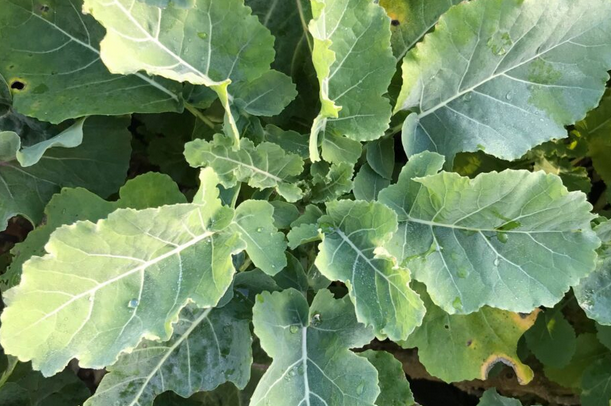Perennial Kale
Brassica oleracea
By plant breeder Chris Homanics comes a perennial kale mix, the Homesteaders Grex. He states that perennial kale is ‘Perfect for the homesteader, the space-intensive gardener, permaculture food foresters.’ provides a year-round source of vital leafy greens. Its perenniality means those same plants will continue producing for a number of years, allowing the grower to create a multi-year rotation plan for their kale patch instead of replanting from seed each season.”
We have tested this kale mix in the Rezenience gardens and greenhouse for a year, and it has yet to go to seed. It tastes like regular kale, although the leaves are slightly thicker. The plants get large, and can be grown in a container or grow bag to keep the size smaller. It is susceptible to damage by cabbage butterfly larvae, the same as annual kale. Be aware that if container grown it will need to be placed in a protected area to successfully overwinter. If planted in the garden, landscape, forest edge, in forest gardening, it is a low care plant that can provide an abundance tasty and nutritious food.
Height:
Zones:
Days to Harvest:
Container: yes, with winter protection
Deer Resistant: unkown
Plant Color: green
Bloom Color:
Life Cycle: perennial, lifespan ~5 years
Spacing:
Juglone Tolerant: unknown
Sunlight: full to part shade
Soil: rich & well-draining
Water: medium, can tolerate drought
Design Styles: potager, forest gardens, silvo-pasture
Guild Use: shrub layer

History
The bedrock of this project was provided by two historic perennial tree kales that seldom flower, ‘Purple Tree Collards’ and ‘Daubenton’. The story is complicated, but these kales were crossed to each other and other Pacific Northwest & West Coast perennial kales as well as a variety of other Brassica oleracea including Baltic Red Kale, Brassica oleracea montana, Brussels sprouts, kohlrabi, Red Cavalier Kale, savoy cabbage, Spis Bladene, Walking Stick Kale, and more. Their progeny have been inter-crossed, reselected, cloned, isolated, reselected, interbred — many times now since 2011.
Uses
These are ways you can use perennial kale in your landscape or farm:
* to replace annual kale in meals
* as a bush or shrub
* perennial area of a potager of kitchen garden
Design
You can place this plant in a potager, kitchen garden, or in an edible food forest. It may lend itself to replace shrubs in a small lot for edible landscaping purposes and design.
Benefits
By choosing perennial kale, you’re securing a fresh green for your kitchen throughout the year. It replaces the need for annual replanting of kale seeds. This plant can also be used in agroforestry silvopasture, and as a dietary component for your livestock, including chickens. This plant holds up well to rotational grazing, and is ideal for alley-cropping with nitrogen fixing trees.
Amount per 1 cup
Calories 100
Total Fat 1 g
Saturated fat 0 g
Cholesterol 0 mg
Sodium 0 mg
Potassium 0 mg
Total Carbohydrate: 27 g
Dietary fiber 10 g
Sugar 0 g
Protein 1 g
___________________________________
Vitamin A 0%
Vitamin C 87%
Vitamin B6 0%
Thiamin (B1) 0%
Vitamin E 0%
Niacin (B3) 0%
Riboflavin (B2) 0%
Folate 0%
* nutrient analysis by the University of
Hawaiʻi at Manoa
% Daily Value
0%
0%
0%
0%
0%
0%
0%
0%
___________________________________
Calcium 0%
Iron 0%
Magnesium 0%
Potassium 0%
Phosphorus 0%
Sodium 0%
Zinc 0%
Parting Thoughts
More to come!
Rezenience Gardens and Design is mission-driven and specializes caring for people and planet.
We do this by providing the most healthful varieties of plants, fruits, and seeds, through
environmentally sound design services, and by means of education.
#PeopleAndPlanet
@Rezenience
